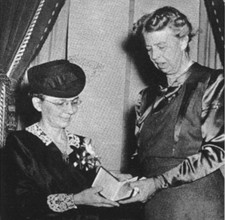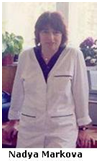 Dr Florence Seibert, receiving an Achievement Award from Mrs Eleanor Roosevelt in 1944
Dr Florence Seibert, receiving an Achievement Award from Mrs Eleanor Roosevelt in 1944
by Mary W Maxwell
Editor’s note: On October 25, 2016, Gumshoe published photos and text of Dr Cantwell’s latest explanation (for laypersons) of his theory of the role of bacteria in cancer. Here, Mary Maxwell asks him a few questions.
Q: Your book, Four Women against Cancer, is a joy to read. Please say a few words about Florence Seibert.
Biochemist Florence B Seibert (1897-1991) developed the first accurate skin test for tuberculosis, which is still used around the world. In August 1990, at the age of 92, she was inducted into the Women’s Hall of Fame, along with Barbara Jordan (government), Billie Jean King (athletics) and Margaret Bourke White (arts).
Seibert was the first to suggest that I study autopsy tissue to determine how widespread the bacteria were that I was finding in the patient’s skin and lymph node tissue of systemic disease.
Her papers relating to the cancer microbe are brilliant, in my view. She has a Wikipedia page, but only a few sentences refer to her “controversial” cancer research to which she was devoted in her last years.
Q: Did you meet any resistance by publishers in medical journals?
A: Some of my medical papers were rejected numerous times, but I persisted. I fully realized how controversial the research was.
Q: I see that Niels Finsen won the Nobel Prize in Physiology or Medicine, in 1903, “in recognition of his contribution to the treatment of diseases, especially lupus vulgaris, with concentrated light radiation, whereby he has opened a new avenue for medical science.” But no one has since capitalized on his discovery – after 113 years. So it isn’t only cancer that we are suppressing the cure for. In Finsen’s case I believe the secret that was not supposed to have come out was the “light” factor.

A: I had to look up Finsen. Ultraviolet (UV) therapy is still sometimes used to treat diseases like psoriasis. But, like sunlight, which contains UV waves, it can increase the incidence of skin cancer and melanoma.
Antimicrobial chemotherapy for all stages of TB came into existence in the late 1940s and 50s and replaced older therapies like UV light for TB of the skin. Along with these newer TB drug regimens has come the severe problem of bacterial resistance. TB and other mycobacterial infections are common in AIDS patients, particularly in the third world.
Q: When did you first get the idea of bacteria in cancer?
A: During my residency training in the early 1960s, I discovered TB-like acid-fast bacteria in scleroderma, and this was reported in the scientific literature.
After my initial discovery, I learned that Virginia Livingston MD, had previously also found acid-fast bacteria in scleroderma, and her research was confirmed at the Pasteur Institute in Brussels. Livingston and her co-workers then went on to find similar forms of pleomorphic bacteria in various forms of cancer.
I learned all I could from them about the “microbiology of cancer” and eventually decided to confirm the work myself, particularly by looking for pleomorphic bacteria in vivo in cancerous tissue.
Q: Do animals get scleroderma? What is its purpose in the body?
A: I am not aware of scleroderma in animals. My research shows infection of the diseased skin with TB-like and pleomorphic bacteria. The skin in scleroderma becomes very hard with “fibrosis”. And, strangely there is often little cellular inflammation, As a result, the scleroderma microbe is easier to see and identify in this condition.
Q: As I understand it, names like leprosy, TB, and syphilis are names of a cluster of symptoms rather than characteristics of the microbe. They could all represent harm done by the same microbe in different stages of its pleomorphism – please correct me on that if I am wrong.
A: You can’t equate the “name” of a disease with its signs and symptoms. All three diseases (TB, leprosy, and syphilis) have a wide variety of clinical expressions. And all three have a certain microscopic appearance in tissue biopsies which can alert a pathologist to suspect these diseases.
Of course, syphilis has a blood test for confirmation and “spirocheates” (syphilis bacteria) can be identified in tissue sections with a special stain. Neither the syphilis germ, nor the leprosy germ has been cultured to the satisfaction of medical science.
Both TB and leprosy tissue can exhibit characteristic tissue changes (so-called tissue “granulomas”) and in both diseases one must identify the acid-fast bacteria in vivo that cause these diseases. A doctor must put together the signs and symptoms, the blood findings, and the tissue findings, in order to come to a proper diagnosis.
Q: Do non-medical scientist such as microbiologists accept the idea of pleomorphism?
A: There is still controversy between “monomorphism” and “pleomorphism” in microbiology. There is no doubt that, in my experience, bacterial isolates from certain diseased states can be pleomorphic.
I don’t think it’s possible to evaluate the case for a “cancer germ” without an appreciation of the various morphologic forms that cell wall deficient bacteria can exhibit. And I don’t think pathologists have much interest or awareness of CWD [cell-wall deficient] bacteria and their possible role in disease.
Q: How many doctors have shown quiet support by adopting your view?
I hate to admit it, but I don’t think I have ever seriously interested any physician to duplicate my findings and those of cancer microbe researchers of the past.
It’s been a half-century since my scleroderma observations, and no other researcher has confirmed (or denied) that TB-like microbes are involved in that disease, or in cancer.
Q: I give you credit for disseminating the work of many young scholars today. Would you care to mention two?
A: I am extremely impressed with the “cell wall deficient” bacterial studies of Nadya Markova and her professor Lilia Michailova of the Institute of Microbiology in Sofia, Bulgaria. Google: “Interview with Nadya Markova,” for an interesting take on her research into these pleomorphic forms.

Also the L-form work of Jeff Errington at Newcastle University in the U.K. Neither of these researchers promotes the “cancer microbe,” but their research is vitally important in assessing the case for a proposed bacterial cause of cancer.
Comment
The above interview was done by email, though I have in the past interviewed Alan Cantwell in California (about his AIDS book, Queer Blood, which is a knockout).
The was a further question that he could not answer, simply “How much would it cost today to buy a microscope like yours?” He has no idea, but it’s an ordinary model – “no big deal.”
He mentioned that if a scholar wants to replicate his studies – and he hopes some will – they have to find a hospital that will hand over some tissue samples.
They will also need perseverance, which is Alan’s great virtue. It sometimes takes hours of looking down the microscope before you can notice the movement of the bacteria.
To repeat, another blessed Cantwell trait is his willingness to help others who can’t get their theories circulated. That’s a trait of all real scientists, in my opinion.
— Mary W Maxwell is a legally-trained conspiracy theorist of suppressed cancer cures. Visit her at maryWmaxwell.com.
Photo credits: Florence Seibert -- todayinwomenshistory.tumblr.com Niels Finsen -- Wikiwand.com Nadya Markova -- Chronicillnessrecovery.org






























In Comments to the previous article, David points to Dr Simoncini’s theory of cancer as fungus.
I need to say that I am no physician and can’t give advice. My book (Consider the Lilies) is about how it is controlled from the top. (In other words, it’s Vintage Mary.)
However, I just went to look up an old article of mine. I typed “Maxwell, inmmune. cancer.” Got this:
https://www.askdrmaxwell.com/2015/08/mebendazole-from-antiparasitic-to-cancer-cure/
Never heard of mebendazole, but it looks interesting.
http://www.curezone.org/forums/fm.asp?i=1296087#i
Edgar Cayce-Those who would eat 2-3 almonds each day need never fear cancer.
I have been eating three Raw Almonds every day for nearly Forty Years so far so good and I follow Cayce Readings saying that a 80% Alkaline 20% food Balance every day is the way to go for good health. I first came across Edgar Cayce Life story in the Book There is a River by Thomas Sugrue Question : How can we tell the difference between a False Prophet and a True Prophet Answer: Judge them by their fruits. Cayce’s Fruits a very good.
Thank you, Terry. Now that you speak of fruits, I recall that there was the great laetrile “crisis,” concerning the pit of apricots, I think, or peaches.
I might not have been interested except that Ed Griffin, who surely is a sober soul, said that he decided to look into it and assumed the research would take a few weeks. It then took him two years and he came out concluding that the item is curative.
Here is a quite lengthy 2007 ineview with Cantwell about his theory (with which I agree) that AIDS was manmade.
http://www.rense.com/general75/mmo.htm
Well, son of a gun. Here also is a review, by me, of the AIDS issue. It is entitled “Their Hearts Were Young and Gay.” It was published in 2005 — where did those 11 years go?
By now, my research is stronger and I take the “genocidal’ position as gospel. In this old review I said Cantwell had just stepped down from his claims. True, but he stepped up again subsequently.
If Dee asks me to hold forth about the Libyan AIDS scandal, I will.
Note: in the review below, there is a man (the late Boyd Graves) who got the Return-to-Sender treatment like Mal Hughes got regarding the Port Arthur massacre. Such records of correspondence have major value as evidence of Guilty Knowledge. Yay, letter-writers!
http://www.informationliberation.com/?id=3954
How can we refuse to hear about that. Is it about the 400 children at the Fatih Clinic at Benghazi infected with AIDS. and the trial — wonder what it had to do with bringing down Gadhafi
Surely pleomorphism is the key to the whole thing. Surely.
[…] Dee McLachlan and I thank you for doing this interview, and also the October 26, 2016 interview on cancer. I’d like to pop up to Los Angeles soon and do the follow-up interview with you on “how the […]
[…] Dee McLachlan and I thank you for doing this interview, and also the October 26, 2016 interview on cancer. I’d like to pop up to Los Angeles soon and do the follow-up interview with you on “how the […]